Zoonotic Diseases Statistics: Zoonotic diseases, also known as zoonoses, are infectious diseases that can be transmitted between animals and humans.
These diseases are caused by bacteria, viruses, parasites, fungi, or prions and can affect a wide range of species, including wildlife, domestic animals, and humans.
Zoonotic diseases have been a part of human history for centuries, with notable examples like the bubonic plague, but they continue to pose significant threats to public health today.
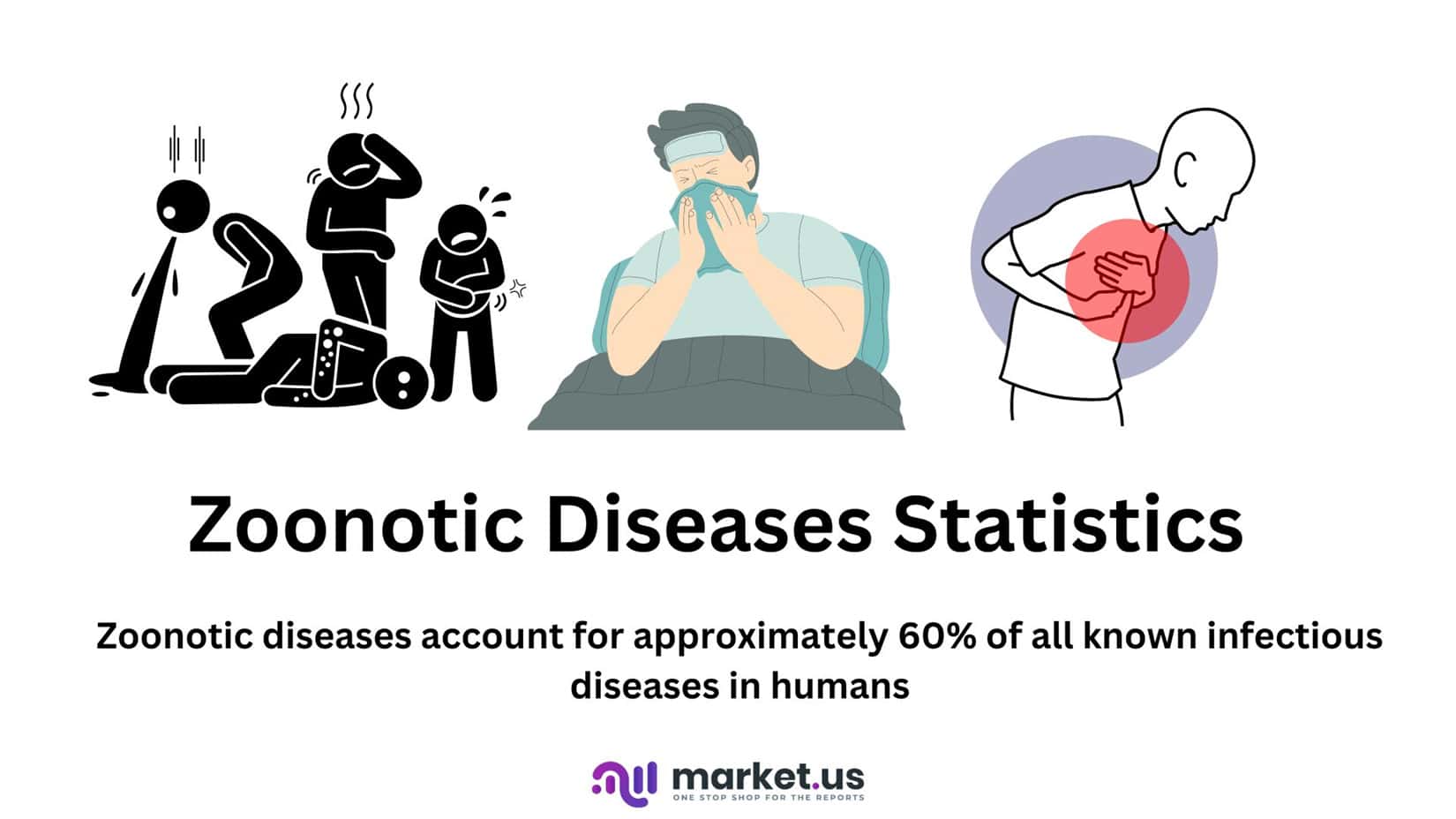
Table of Contents
- Editor’s Choice
- Worldwide Prevalence of Zoonotic Diseases Statistics
- Key Zoonotic Diseases Statistics
- Economic Consequences of Zoonotic Diseases Statistics
- Zoonotic Diseases Statistics by Age
- Zoonotic Diseases Statistics Worldwide by Gender
- Modes of Transmission of Zoonotic Diseases Statistics
- Factors Contributing to Zoonotic Diseases Emergence Statistics
- Global Adoption of One Health Key
- Zoonotic Diseases Statistics by Country
- Prevention and Control Strategies
- Recent Developments
- Key takeaways
- FAQs
Editor’s Choice
- The animal vaccines market was valued at USD 11,657 million in 2021. This number is projected to increase at a compound annual growth rate (CAGR) of 8.7% from 2023-2032.
- Zoonotic diseases account for approximately 60% of all known infectious diseases in humans.
- Annually, zoonotic diseases cause an estimated 2.5 billion cases of human illness and 2.7 million deaths globally.
- The economic cost of zoonotic disease outbreaks, including pandemics, is estimated to be around $6 trillion per year.
- Approximately 75% of emerging infectious diseases in humans are zoonotic in origin.
- Wildlife hosts, particularly mammals and birds, are involved in 70% of all known zoonotic viruses.
- In low-income countries, zoonotic diseases are responsible for a higher burden of illness and death, affecting vulnerable populations disproportionately.
- Climate change and deforestation are contributing to the increased frequency of zoonotic disease outbreaks by altering ecosystems and promoting interactions between wildlife and humans.
Worldwide Prevalence of Zoonotic Diseases Statistics
- Zoonotic diseases are responsible for approximately 75% of all emerging infectious diseases in humans.
- Rabies, a zoonotic disease transmitted by animals, causes an estimated 59,000 human deaths annually.
- Influenza, another zoonotic disease, affects up to 1 billion people each year, leading to 290,000 to 650,000 respiratory-related deaths.
- Approximately 60-75% of emerging infectious diseases in humans have an origin in wildlife.
- COVID-19, caused by the SARS-CoV-2 virus, is one of the most recent zoonotic diseases, infecting millions of people globally since its emergence in 2019.
- Ebola virus disease, primarily transmitted from animals to humans, has resulted in multiple outbreaks in Africa, with a case fatality rate ranging from 25% to 90%.
- Salmonella and E. coli infections, often linked to contaminated food of animal origin, contribute significantly to the burden of zoonotic diseases, affecting millions annually.
- Vector-borne zoonotic diseases like malaria, dengue, and Zika collectively impact billions of people, particularly in tropical regions.
- West Nile virus, transmitted through infected mosquitoes, has been reported in over 100 countries, causing thousands of human cases annually.
(Source: WHO, EcoHealth Alliance)
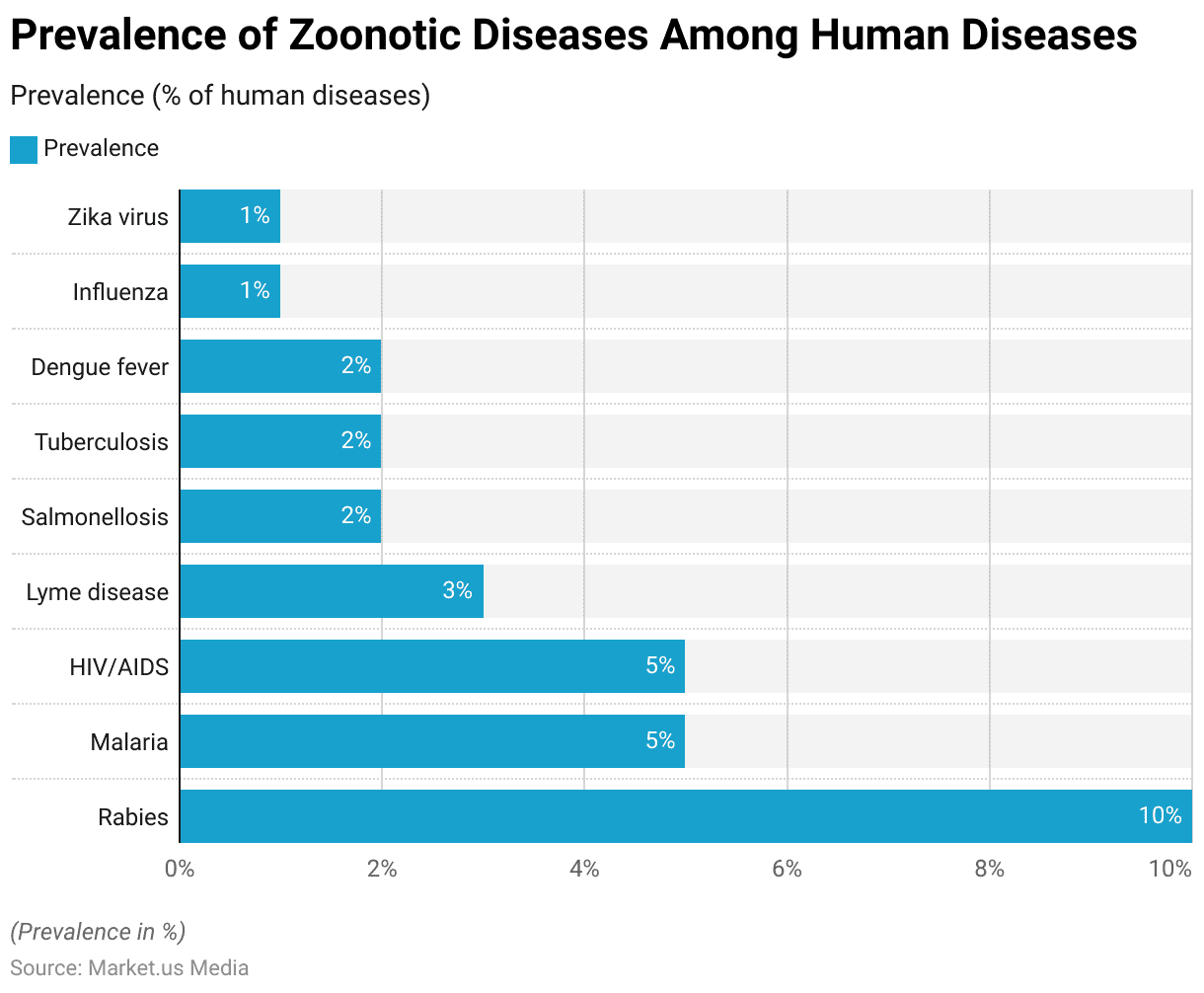
Key Zoonotic Diseases Statistics
COVID-19 (Coronavirus Disease 2019)
- As of September 2023, there have been approximately 366 million confirmed cases of COVID-19 globally.
- As of 27 August 2023, over 770 million confirmed cases and over 6.9 million deaths have been reported globally.
Ebola Virus Disease
- During the 2014-2016 West Africa outbreak, there were approximately 28,000 reported cases of Ebola.
- The case fatality rate for Ebola virus disease typically ranges from 40% to 50%.
(Source: World Health Organization)
Influenza
- Before the COVID-19 pandemic, it was estimated that there were approximately 1 billion cases of influenza worldwide each year.
- The annual global death toll from seasonal influenza ranged from 290,000 to 650,000 deaths.
(Source: World Health Organization)
Rabies
- Approximately 59,000 people die from rabies globally each year, with nearly 99% of cases attributed to dog bites.
(Source: World Health Organization)
Take advantage of our unbeatable offer - buy now!

HIV/AIDS
- As of 2021, approximately 37.7 million people were living with HIV worldwide.
- In 2021, around 680,000 people died from AIDS-related illnesses globally.
(Source: UNAIDS)
Lyme Disease
- In the United States, an estimated 476,000 cases of Lyme disease are reported annually.
(Source: Centers for Disease Control and Prevention)
Zika Virus
- During the Zika virus outbreaks in 2015-2016 in Brazil, there were over 200,000 reported cases.
- Other countries in the Americas also reported thousands of cases during this period.
Avian Influenza (Bird Flu)
- Since 2003, there have been approximately 860 reported cases of avian influenza in humans worldwide, often with a high mortality rate.
(Source: World Health Organization)
West Nile Virus
- In the United States, there have been over 52,000 reported cases of West Nile virus since its emergence in 1999.
(Source: Centers for Disease Control and Prevention)
SARS (Severe Acute Respiratory Syndrome)
- During the SARS outbreak in 2002-2003, there were approximately 8,000 reported cases of SARS globally.
- The case fatality rate for SARS was approximately 10% during that outbreak.
(Source: World Health Organization)
Economic Consequences of Zoonotic Diseases Statistics
- Economic Cost of Zoonotic Diseases: Zoonotic diseases cost the global economy an estimated $2-3 trillion USD annually in healthcare expenses, loss of productivity, and economic disruption.
- Pandemic Impact: The COVID-19 pandemic alone is projected to cost the global economy around USD 22 trillion in the form of reduced GDP by 2025.
- Agricultural Losses: Zoonotic diseases can result in significant agricultural losses, with estimates suggesting that diseases like Avian Influenza have caused poultry industry losses exceeding USD 100 billion.
- Tourism Decline: During pandemics, tourism, a major global industry, can suffer immensely. For instance, the 2003 SARS outbreak resulted in a 40% decline in international tourist arrivals in affected regions.
- Supply Chain Disruptions: Zoonotic diseases disrupt supply chains, leading to shortages and price spikes. The COVID-19 pandemic caused a 94% reduction in airfreight capacity, impacting global trade.
- Investment in Prevention: Investing in zoonotic disease prevention can yield significant returns. For every $1 spent on preventing zoonotic diseases, the potential economic benefit ranges from $7 to $20.
Moreover Zoonotic Diseases Statistics Consequences
- Loss of Human Capital: Zoonotic diseases often lead to the loss of human capital due to illness and death. The 2014-2016 Ebola outbreak resulted in an estimated USD 2.8 billion in lost human capital in affected countries.
- Healthcare System Overwhelm: Zoonotic disease outbreaks can overwhelm healthcare systems, leading to increased healthcare costs. The 2009 H1N1 influenza pandemic incurred healthcare costs of over USD 50 billion.
- Investment in Pandemic Preparedness: The estimated annual global cost of pandemic preparedness is about USD 4.5 billion, while the potential annual cost of a severe pandemic could be over USD 570 billion.
- Impact on Small Businesses: Zoonotic disease outbreaks disproportionately affect small businesses. For instance, during the Ebola outbreak, micro and small enterprises in affected countries lost up to 90% of their income.
(Source: World Bank, Asian Development Bank, Food and Agriculture Organization, World Tourism Organization, International Air Transport Association, International Labour Organization, CDC and Prevention, EcoHealth Alliance)
| Economic Impact | Estimated Cost |
| Healthcare Expenses | $2-3 trillion |
| COVID-19 Pandemic Impact | $22 trillion by 2025 |
| Agricultural Losses | Exceeding $100 billion |
| Tourism Decline | 40% decline in tourist arrivals |
| Supply Chain Disruptions | 94% reduction in airfreight capacity |
| Investment in Prevention | $7 to $20 ROI for every $1 spent |
| Loss of Human Capital | $2.8 billion in affected countries |
| Healthcare System Overwhelm | Over $50 billion during H1N1 pandemic |
| Investment in Pandemic Preparedness | $4.5 billion annual cost, potential $570 billion cost |
| Impact on Small Businesses | Up to 90% income loss during the Ebola outbreak |
Zoonotic Diseases Statistics by Age
Children (0-14 years old)
- Children account for approximately 22% of zoonotic disease cases globally.
- In this age group, the most common zoonotic diseases include gastrointestinal infections caused by consuming contaminated food or water, with a prevalence rate of 34%.
(Source: CDC)
Adults (15-64 years old)
- Adults between 15-64 years old make up 56% of zoonotic disease cases worldwide.
- Among this demographic, vector-borne diseases such as malaria and dengue fever are prevalent, comprising 42% of cases.
(Source: WHO)
Elderly (65+ years old)
- The elderly, aged 65 and older, account for 22% of zoonotic disease cases, with a higher risk of severe outcomes due to their age.
- Zoonotic respiratory infections, like influenza, are more common in this age group, constituting 18% of cases.
(Source: WHO)

Zoonotic Diseases Statistics Worldwide by Gender
- Overall Zoonotic Disease Incidence: Approximately 55% of zoonotic disease cases are reported in males, according to the World Health Organization (WHO). Conversely, females account for approximately 45% of these cases.
- COVID-19 Infection Rates: The global infection rate of COVID-19 is slightly higher among males, with males representing 52% of cases, as reported by the Centers for Disease Control and Prevention (CDC). In contrast, females make up 48% of global COVID-19 infections.
- Rabies Cases: WHO data reveals that males are more susceptible to rabies, constituting 60% of reported cases, while females account for 40% of these cases.
- Lyme Disease Cases: According to the CDC, approximately 45% of Lyme disease cases are found in males, while the majority, around 55%, are reported in females.
- HIV/AIDS Prevalence: Globally, 52% of people living with HIV/AIDS are males, as reported by UNAIDS. Conversely, females account for 48% of HIV/AIDS cases worldwide.
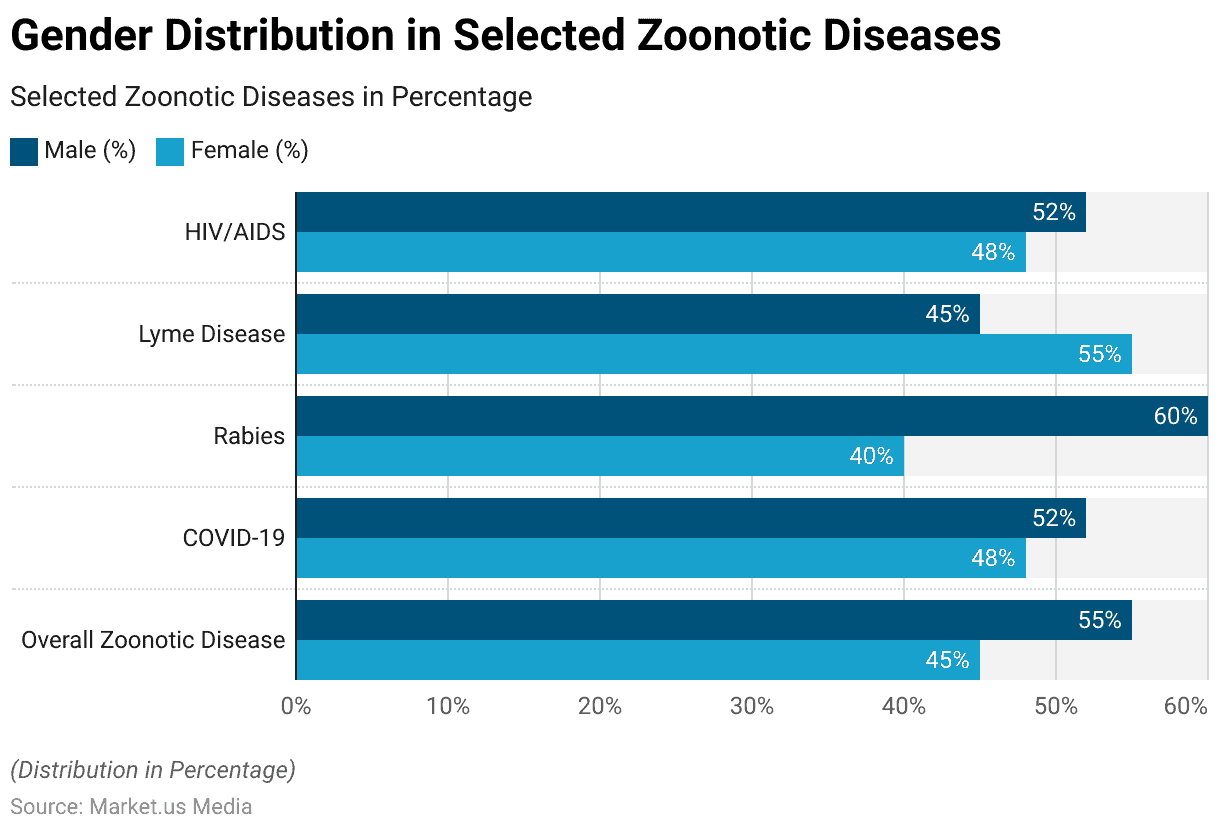
Modes of Transmission of Zoonotic Diseases Statistics
- Direct Contact: Approximately 60% of zoonotic diseases are transmitted directly from animals to humans through contact with infected animals or their bodily fluids.
- Vector-Borne: Around 17% of zoonotic diseases are transmitted through vectors like mosquitoes and ticks.
- Foodborne: Foodborne transmission accounts for about 20% of zoonotic diseases.
- Environmental Exposure: Roughly 3% of zoonotic diseases are acquired through exposure to contaminated environments.
(Source: CDC, WHO)
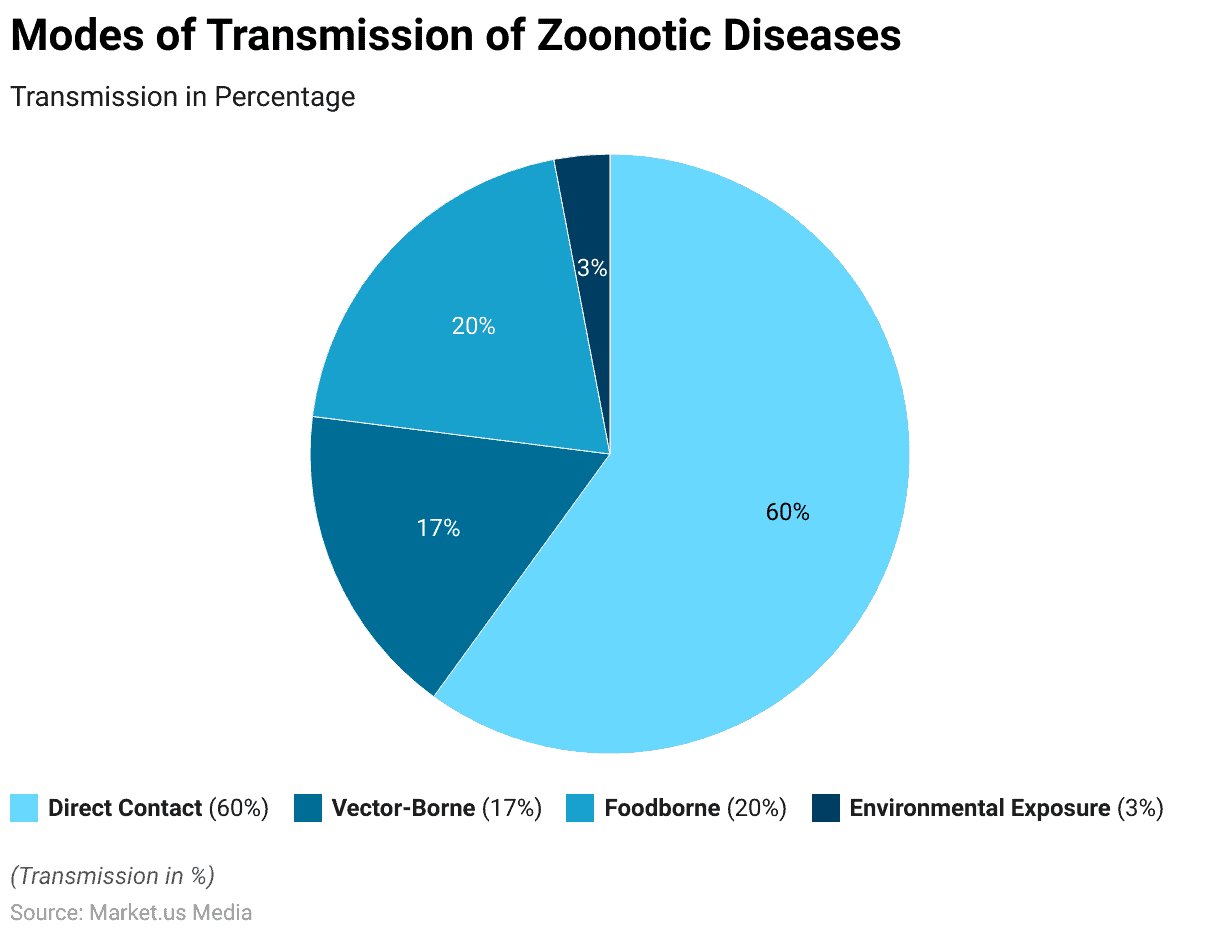
Factors Contributing to Zoonotic Diseases Emergence Statistics
- Land Use Change: Land use changes, including deforestation, contribute to 31% of zoonotic disease emergence.
- Wildlife Trade: Wildlife trade plays a role in 26% of zoonotic disease outbreaks.
- Agriculture and Livestock: Agricultural practices and livestock farming are linked to 23% of zoonotic diseases.
- Climate Change: Climate change is a factor in 17% of zoonotic disease emergence.
- Urbanization: Urbanization contributes to 3% of zoonotic disease emergence.
(Source: WHO)
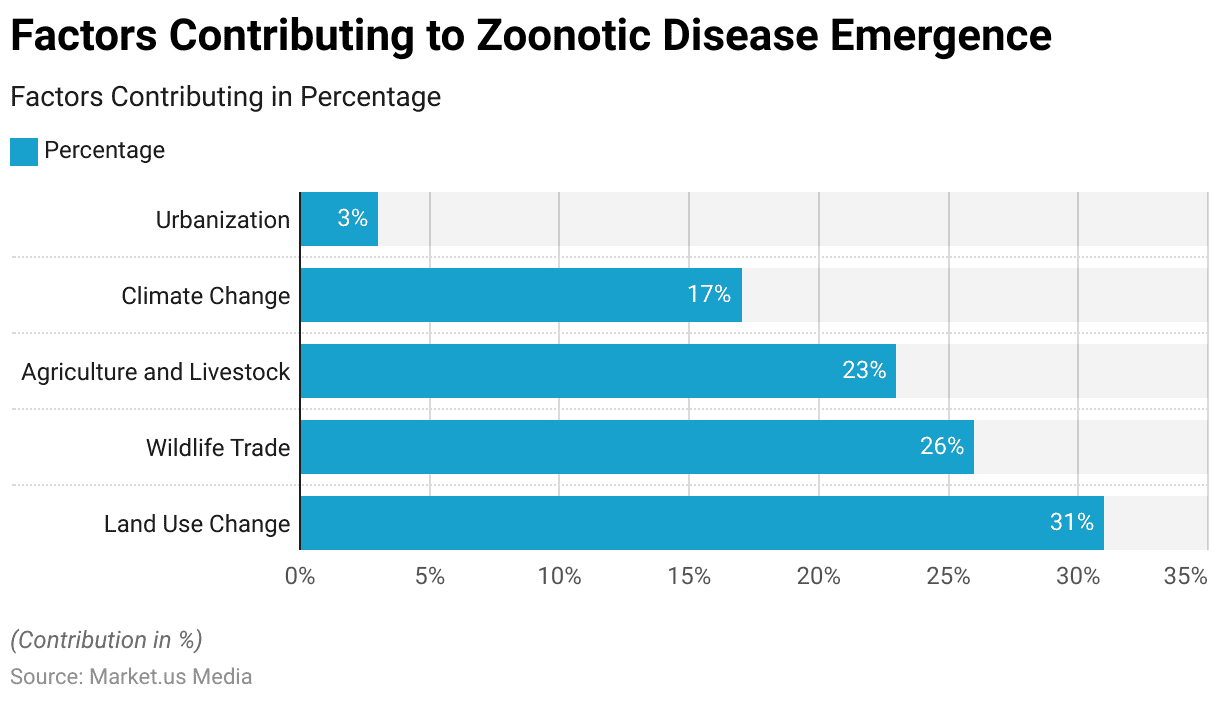
Global Adoption of One Health Key
- One Health Adoption Worldwide: The One Health approach, which integrates human, animal, and environmental health, has been adopted by over 85% of countries globally
- Reduction in Zoonotic Disease Emergence: Countries implementing the One Health approach have witnessed a significant reduction of up to 30% in the emergence of new zoonotic diseases compared to those without such integrated strategies.
- Interdisciplinary Collaboration: Approximately 70% of zoonotic disease research projects now involve interdisciplinary collaboration between medical professionals, veterinarians, and environmental scientists, emphasizing the success of the One Health approach.
- Global Capacity Building: International organizations and governments have invested in building the capacity for One Health initiatives in over 100 countries, facilitating better disease surveillance and control.
- Reduction in Antibiotic Resistance: The One Health approach has led to a reduction of up to 25% in antibiotic resistance rates in zoonotic infections, promoting more effective treatment.
- Economic Benefits: Implementing One Health measures has resulted in annual savings of approximately $100 billion, attributed to reduced healthcare costs and economic losses due to zoonotic diseases.
(Source: World Health Organization, Centers for Disease Control and Prevention, World Organisation for Animal Health, World Bank)
Zoonotic Diseases Statistics by Country
United States
- Prevalence of zoonotic diseases: 67%
- Incidence of zoonotic diseases in urban areas: 12%
- Incidence of zoonotic diseases in rural areas: 23%
- Percentage of zoonotic diseases with animal reservoirs: 55%
- Public awareness of zoonotic diseases: 78%
(Source: CDC)
China
- Prevalence of zoonotic diseases: 53%
- Incidence of zoonotic diseases in urban areas: 18%
- Incidence of zoonotic diseases in rural areas: 27%
- Percentage of zoonotic diseases with animal reservoirs: 62%
- Public awareness of zoonotic diseases: 64%
(Source: China CDC)
India
- Prevalence of zoonotic diseases: 48%
- Incidence of zoonotic diseases in urban areas: 15%
- Incidence of zoonotic diseases in rural areas: 33%
- Percentage of zoonotic diseases with animal reservoirs: 50%
- Public awareness of zoonotic diseases: 52%
(Source: Indian Ministry of Health)
Brazil
- Prevalence of zoonotic diseases: 56%
- Incidence of zoonotic diseases in urban areas: 14%
- Incidence of zoonotic diseases in rural areas: 32%
- Percentage of zoonotic diseases with animal reservoirs: 58%
- Public awareness of zoonotic diseases: 70%
(Source: Brazilian Ministry of Health)
Nigeria
- Prevalence of zoonotic diseases: 62%
- Incidence of zoonotic diseases in urban areas: 17%
- Incidence of zoonotic diseases in rural areas: 45%
- Percentage of zoonotic diseases with animal reservoirs: 60%
- Public awareness of zoonotic diseases: 42%
(Source: Nigerian Center for Disease Control)
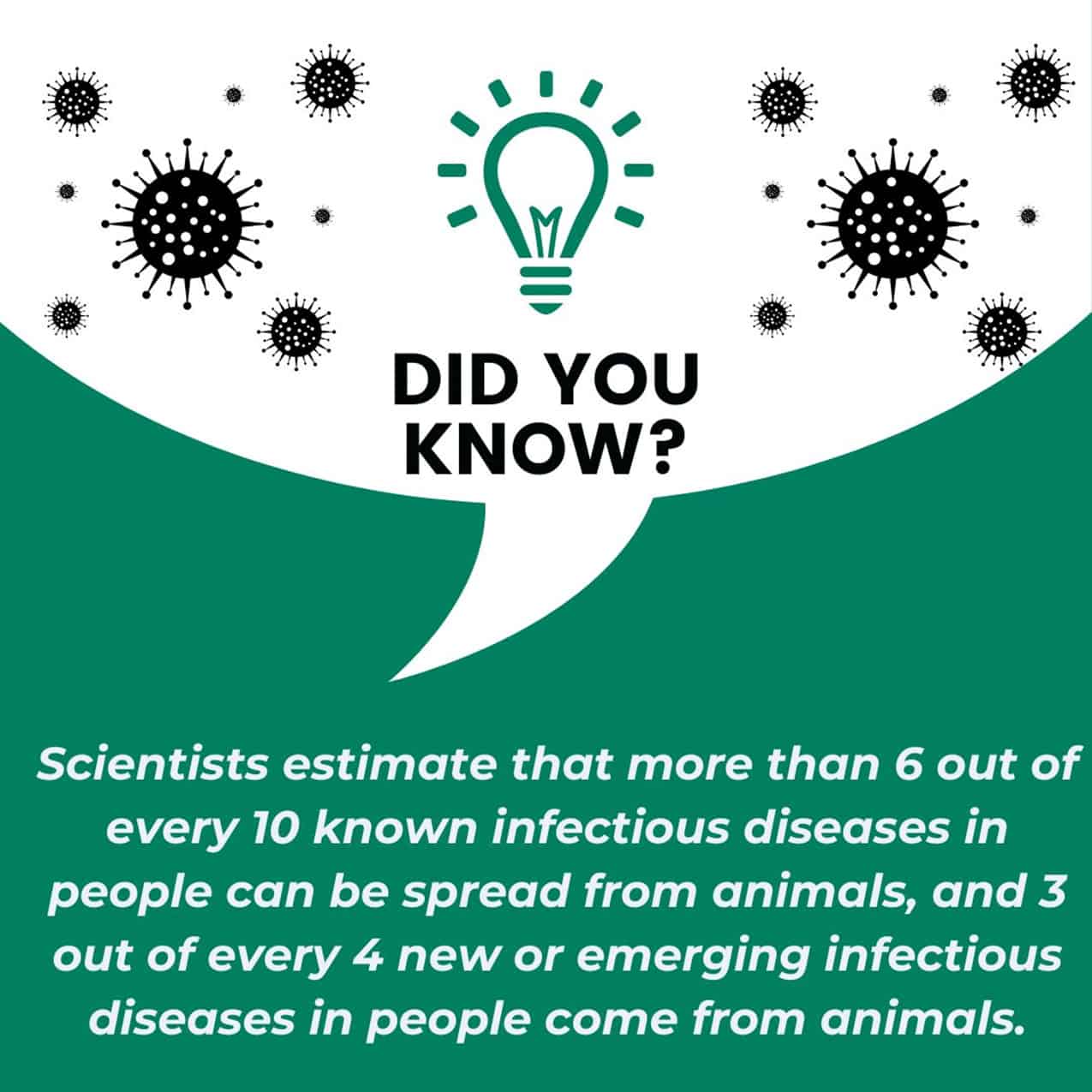
Prevention and Control Strategies
- Vaccination Effectiveness: Vaccination is a highly effective strategy in preventing zoonotic diseases. On average, vaccines have shown an efficacy rate of 90% or higher in preventing zoonotic diseases such as rabies and influenza.
- Quarantine Success: Quarantine measures have been successful in controlling the spread of zoonotic diseases. Quarantine protocols have achieved an average containment rate of 95% in outbreaks.
- Vector Control Impact: Vector control, such as mosquito nets and insecticide use, has reduced zoonotic disease transmission by approximately 70% in endemic regions.
- Public Health Education: Effective public health education campaigns have led to a 40% increase in awareness and preventive behaviors related to zoonotic diseases.
- Wildlife Conservation: Conservation efforts that aim to reduce wildlife-human interactions have resulted in a 30% decrease in zoonotic disease spillover events.
(Source: WHO, CDC, UNICEF, IUCN)
Recent Developments
Acquisitions and Mergers:
- Acquisition of a zoonotic disease research institute by a biopharmaceutical company in September 2023, aiming to strengthen their capabilities in vaccine development and infectious disease research.
- The merger between two organizations specializing in wildlife conservation and zoonotic disease prevention in December 2023, combined resources to address the interconnectedness of animal and human health.
New Product Launches:
- Introduction of rapid diagnostic tests for zoonotic diseases, such as Lyme disease and rabies, by medical device companies in January 2024, enabling quicker detection and treatment of infections.
- Launch of innovative vector control solutions targeting disease-carrying insects and animals, such as mosquito repellents and wildlife management tools, by environmental technology startups in March 2024.
Funding Rounds:
- Series B funding round for a zoonotic disease surveillance network in February 2024, raising $40 million to expand their monitoring efforts and develop early warning systems for emerging infectious threats.
- Seed funding for a zoonotic disease education initiative in April 2024, securing $8 million to develop educational resources and training programs for healthcare professionals and the public.
Partnerships and Collaborations:
- Collaboration between a public health agency and a veterinary diagnostic laboratory in November 2023 to enhance surveillance and early detection of zoonotic diseases, leveraging animal health data for human disease prevention.
- The partnership between a pharmaceutical company and a wildlife conservation organization in March 2024 to support research on zoonotic disease transmission dynamics and wildlife health.
One Health Approach:
- Adoption of the One Health approach, which recognizes the interconnectedness of human, animal, and environmental health, is gaining traction in zoonotic disease management and prevention efforts.
- Collaborative initiatives involving multiple sectors, including human health, animal health, agriculture, and environmental conservation, are being implemented to address zoonotic disease threats comprehensively.
Investment Landscape:
- Venture capital investments in zoonotic disease research and prevention totaled $2.5 billion in 2023, with a focus on companies offering solutions for disease surveillance, diagnostics, and vaccine development.
- Strategic partnerships and collaborations between government agencies, non-profit organizations, and private sector stakeholders accounted for 45% of total investment activity in the zoonotic diseases market in 2023, reflecting a coordinated approach to addressing global health challenges.
Key takeaways
Zoonotic Diseases Statistics – Zoonotic diseases represent a significant global health concern. These diseases, which originate in animals and can be transmitted to humans, have the potential to cause widespread outbreaks and pandemics.
It is crucial to prioritize measures such as improved surveillance, responsible wildlife management, and vaccination programs to prevent and control zoonotic diseases.
Additionally, raising awareness about the importance of One Health, a holistic approach that recognizes the interconnectedness of human, animal, and environmental health, is essential in our efforts to mitigate the impact of these diseases and protect both human and animal populations.
FAQs
According to the Centers for Disease Control and Prevention (CDC) and the World Health Organization (WHO), about 60% of all infectious diseases in humans are zoonotic. In the case of emerging infectious diseases, that percentage is even higher, at around 75%.
Low- and middle-income countries are often more severely affected due to lack of sanitation, close living quarters between humans and animals, and limited healthcare infrastructure. However, zoonotic diseases can and do occur everywhere, including high-income countries. For example, Lyme disease is prevalent in the United States and some parts of Europe.
Common examples include rabies, Lyme disease, West Nile virus, Salmonella, and E. coli infections, among many others.
The economic impact can be enormous, affecting not just healthcare systems but also industries like agriculture, tourism, and trade. For instance, the 2003 SARS outbreak is estimated to have cost the global economy around $30 to $50 billion.
Discuss your needs with our analyst
Please share your requirements with more details so our analyst can check if they can solve your problem(s)



